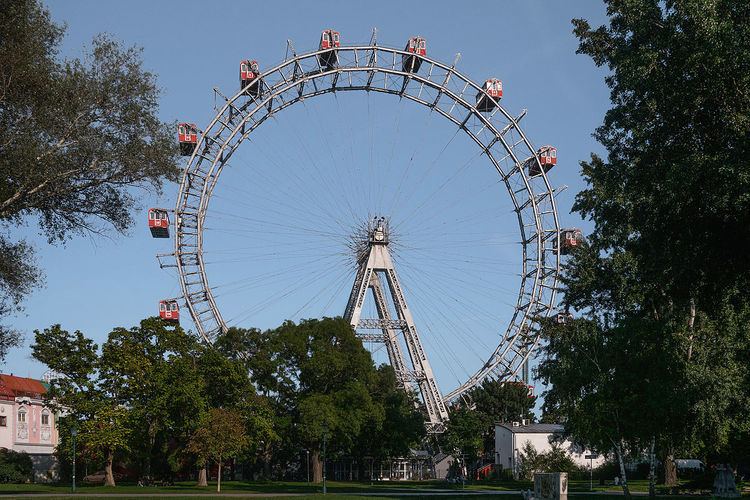Height 65 m Phone +43 1 7295430 | Opened 1897 | |
 | ||
Hours Open today · 9AM–11:45PMSunday9AM–11:45PMMonday9AM–11:45PMTuesday9AM–11:45PMWednesday9AM–11:45PMThursday9AM–11:45PMFriday9AM–11:45PMSaturday9AM–11:45PMSuggest an edit Owners Hans-Peter Petritsch, Dorothea Lamac Architects Harry Hitchins, Walter Basset Bassett Similar Prater, Wurstelprater, St Stephen's Cathedral, Donauturm, Schönbrunn Palace Profiles | ||
Wiener riesenrad prater wien
The Wiener Riesenrad (German for Vienna Giant Wheel), or Riesenrad, is a 64.75-metre (212 ft) tall Ferris wheel at the entrance of the Prater amusement park in Leopoldstadt, the 2nd district of Austria's capital Vienna. It is one of Vienna's most popular tourist attractions, and symbolises the district as well as the city for many people. Constructed in 1897, it was the world's tallest extant Ferris wheel from 1920 until 1985.
Contents
Wiener riesenrad
History
The Wiener Riesenrad was constructed in 1897 by the English engineer Lieutenant Walter Bassett Bassett (1864-1907), Royal Navy, son of Charles Bassett (1834-1908), MP, of Watermouth Castle, Devon. Its purpose was to celebrate the Golden Jubilee of Emperor Franz Josef I, and it was one of the earliest Ferris wheels ever built. Bassett's Ferris wheel manufacturing business was not a commercial success, and he died in 1907 almost bankrupt.
A permit for its demolition was issued in 1916, but because of a lack of funds with which to carry out the destruction, it survived.
The Ferris wheel and cafe on the Prater were owned by a Jew, Eduard Steiner, who was murdered at Auschwitz.
It was built with 30 gondolas, but was severely damaged in World War II and when it was rebuilt only 15 gondolas were replaced.
The wheel is driven by a circumferential cable which leaves the wheel and passes through the drive mechanism under the base, and its spokes are steel cables, in tension.
Height
When the 64.75-metre (212 ft) tall Wiener Riesenrad was constructed in 1897, both the original 80.4-metre (264 ft) Ferris Wheel in the US (constructed 1893, demolished 1906) and the 94-metre (308 ft) Great Wheel in England (constructed 1895, demolished 1907) were taller. The 100-metre (328 ft) Grande Roue de Paris, constructed in 1900, was taller still. However, when the Grande Roue de Paris was demolished in 1920, the Riesenrad became the world's tallest extant Ferris wheel, and it remained so for the next 65 years, until the construction of the 85-metre (279 ft) Technostar in Japan in 1985.
